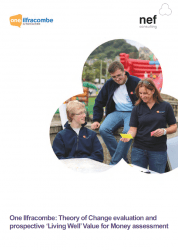Theory of Change evaluation and prospective ‘Living Well’ Value for Money assessment.
 Ilfracombe is a small seaside town that attracts retirees and has an ageing population that makes up around a third of the town’s total population. One Ilfracombe aims to give residents increased participation in the design and delivery of local services. Its focus is on modelling a different way of organising services in the town.
Ilfracombe is a small seaside town that attracts retirees and has an ageing population that makes up around a third of the town’s total population. One Ilfracombe aims to give residents increased participation in the design and delivery of local services. Its focus is on modelling a different way of organising services in the town.
The imperative for cost reductions across the public sector over the last few years has led to an interest in finding new ways to manage resources. Increased efficiency within the existing service-model structure can only reduce costs to a certain extent. Local authorities and partners are therefore looking for new, longer-term models, which will allow them to manage service delivery while also cutting budgets.
One Ilfracombe aims to model integration of local, regional and national budgets. The joining up of local and national budgets by removing budget ring-fences involves using all public funding available in an area to reorganise services around local needs, by breaking down traditional ‘silos’ and the vertical organisation of public services. The logic follows that by working with local residents to co-produce outcomes, this approach will meet existing demand for public services more efficiently, while reducing future demand and unlocking further resources.
NEF Consulting report
Our report examines and evaluates the robustness of One Ilfracombe’s integrated service model and its potential for cost savings. A Theory of Change (ToC) evaluation and two prospective Value for Money (VfM) assessments are presented to explore the coherence of One Ilfracombe’s plans, and to estimate potential State savings arising from health and wellbeing initiatives, known collectively as ‘Living Well’, which target elderly residents (one of Ilfracombe’s initial projects).
The Theory of Change analysis found that:
- One Ilfracombe expects services to integrate their delivery in the short term via co-ordination and better communication, and in the medium term through the progressive pooling of budgets and the creation of new governance structures which are people-centred.
- Resident participation is key to the success of the model and One Ilfracombe will work alongside public sector agencies to design, deliver and evaluate services. This will increase volunteering capacity in the town, adding to and complementing public resources. This is expected to contribute to the enhancement of outcomes in the social, economic and physical domains.
Value for Money assessments of the Living Well programme findings included (see the report for the full findings):
- State savings could range between £518 and £31,711 per individual older resident, depending on medical history. As there is a high number of residents aged 50-plus living in Ilfracombe, total savings could be significant.
- If the project resolves 100 social and care needs per year the ratio of net fiscal Return on Investment will be between 1:2.4 and 1:3.3. i.e. for each £1 invested the return (in terms of reduced demand or savings to the State) will be over £2.
- The key to achieving these savings is to reduce demand, by better meeting people’s needs and investing more in factors that prevent problems from arising in the first place.
- The Living Well model will involve local residents, whose active participation will lead to an increase in the capacity of services, which should avoid and reduce service costs as well as enrich the social environment in the town.
